What is AI Automation? Explanation and Applied Uses
Learn AI automation basics without the complex tech talk.
 April 16, 2025
April 16, 2025 8 minute reading
8 minute reading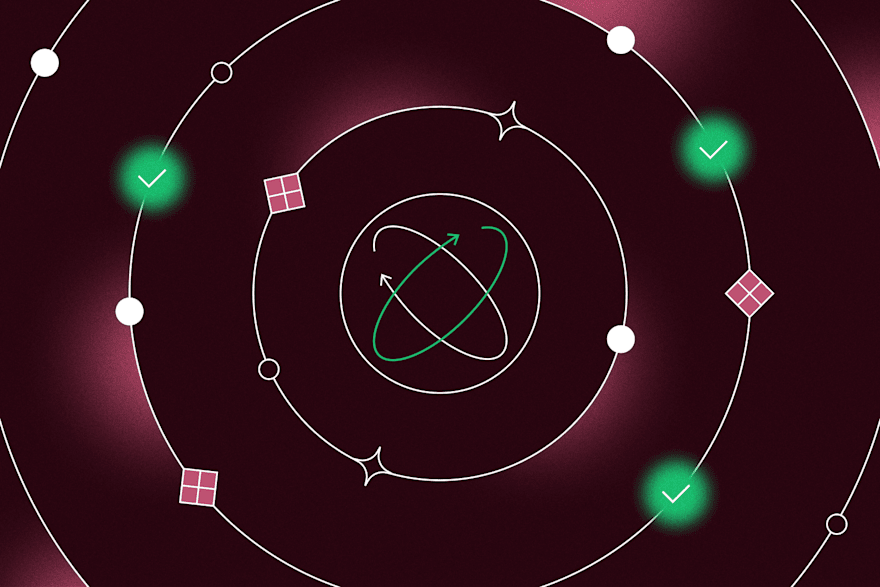
Business automation can save you time and money, but traditional automation can be rigid and limited. Building advanced automations with these legacy systems can lead to immense complexity.
AI automation is a game-changer, allowing you to create scalable and adaptable solutions through AI services for almost any use case.
In this article, we dive into what AI automation is, how it works, and how to get started with it.
What is AI automation?
AI automation is the process of building automation technologies that work together with artificial intelligence (AI) and machine learning (ML). It differs from traditional automation tools such as robotic process automation (RPA).
RPA refers to “software robots,” not physical robots. RPA automation systems use a rule-based approach. Users implement workflows to handle routine tasks, such as automatically forwarding an email that contains a certain phrase.
Traditional automation tools lack scalability, whereas AI automation (or “intelligent automation”) can scale automatically if built properly. AI-powered automation requires less human intervention and uses cutting-edge AI tools such as computer vision, natural language processing (NLP), large language models (LLMs), and speech recognition to adapt to the business process it’s automating.
Prebuilt AI systems exist that you can set up using a DIY interface, or you can build your own AI automation system through custom AI programming.
How AI automation works
AI automation is related to business process management (BPM), which Gartner defines as “a discipline that uses various methods to discover, model, analyze, measure, improve and optimize business processes…Processes can be structured and repeatable, or unstructured and variable.”
Traditional automation has focused on automating structured and repetitive tasks to achieve cost savings, boost productivity, reduce human error, and optimize workflows. However, it struggles when a task is “unstructured and variable.”
AI-driven solutions combine problem-solving algorithms and deep learning to help them understand unstructured workloads, enabling them to perform automated actions on those workloads.
To demonstrate this, imagine a custom-programmed virtual assistant that processes emails and then triggers automated actions based on the content. The automated actions might include:
Updating customer data in a CRM (customer relationship management tool)
Opening a customer support ticket
Triggering a workflow in an automated marketing campaign
To create such a system, you’d connect your AI automation tool to a generative AI model such as Claude or ChatGPT through an API integration. The integration could provide the AI model with instructions to output the text in a structured format that a non-AI tool can understand.
We demonstrate this in a screenshot below by typing it directly into the Claude chatbot. However, a real tool would provide these instructions in the integration’s source code.
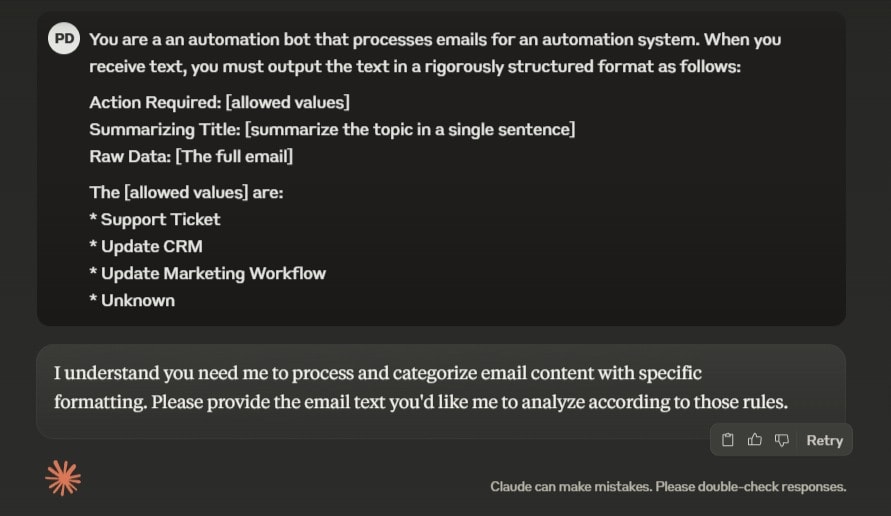
Claude
As shown below, Claude provides a precise structured format based on the received email text. A separate tool can then use this structured response to perform automated actions.
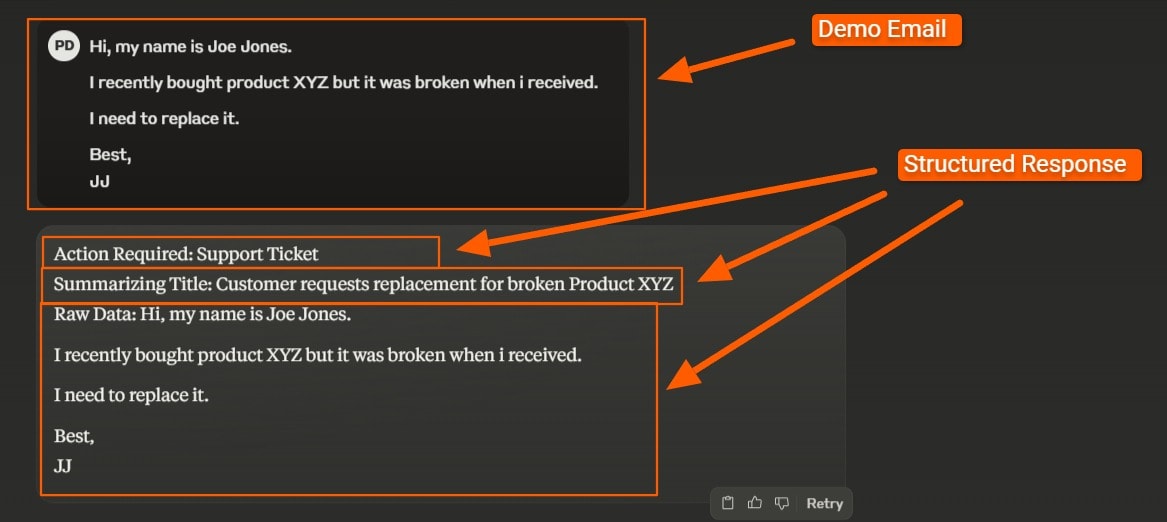
Claude
The above demo is simplistic, and yet it’s already far more powerful than any automation that has existed before. It’s possible to chain AI workflows together to build adaptability into the system.
For example, separate instructions might exist for each “Action Required” step. In the case of “Update CRM,” your tool could define the precise field names that must be updated, and instruct the AI to output the data using those field names. A separate tool can then read those fields and automatically add them to the CRM, making data entry by a human unnecessary.
In the case of a support ticket, the AI tool could structure the data in a format that your tool sends a follow-up email asking for the product’s serial number.
The options regarding how sophisticated you can make such a tool are limited only by your imagination and skill. You can find the skill and talent on Fiverr by using an expert AI strategy consultants.
Find an AI specialist for hire
AI automation needs other technologies
AI automation is about increasing operational efficiency through tools that try to mimic human intelligence. AI algorithms can’t automate workflows. When building an AI automation, AI uses other technologies to augment its abilities.
Even RPA has a place in AI automation. Once the AI has converted unstructured new data into structured data, a traditional RPA process can take over.
Machine learning
The line between machine learning and AI has grown blurry. The two technologies are increasingly used together to provide comprehensive AI solutions that wouldn’t be possible by using only one tech alone.
The recent breakthroughs in generative AI were mostly powered by powerful deep learning across vast amounts of data.
Similarly, AI automation tools can adapt because the underlying ML continues to process new data in real time. For example, a website might continually process customer interactions on its website so the ML can obtain insight into which parts of the website might be turning users away.
You could build an AI automation tool to open issues for the development team to build advancements into the website for these newly discovered weak spots.
Machine learning is required for data analysis and predictive analytics, which are crucial to building state-of-the-art AI solutions.
Robotic Process Automation
RPAs remain an essential aspect of AI automation. Once your AI tool has processed the incoming data, a separate tool must take action.
RPAs use “software bots” to automate repetitive tasks that work on structured data. They’re typically configured using a graphical user interface, so you don’t have to know how to code to create one. However, you can also create RPAs using popular programming languages like Python or Java. You could also find a software development expert on Fiverr to help you.
Two popular enterprise RPA solutions are UiPath and Automation Anywhere.
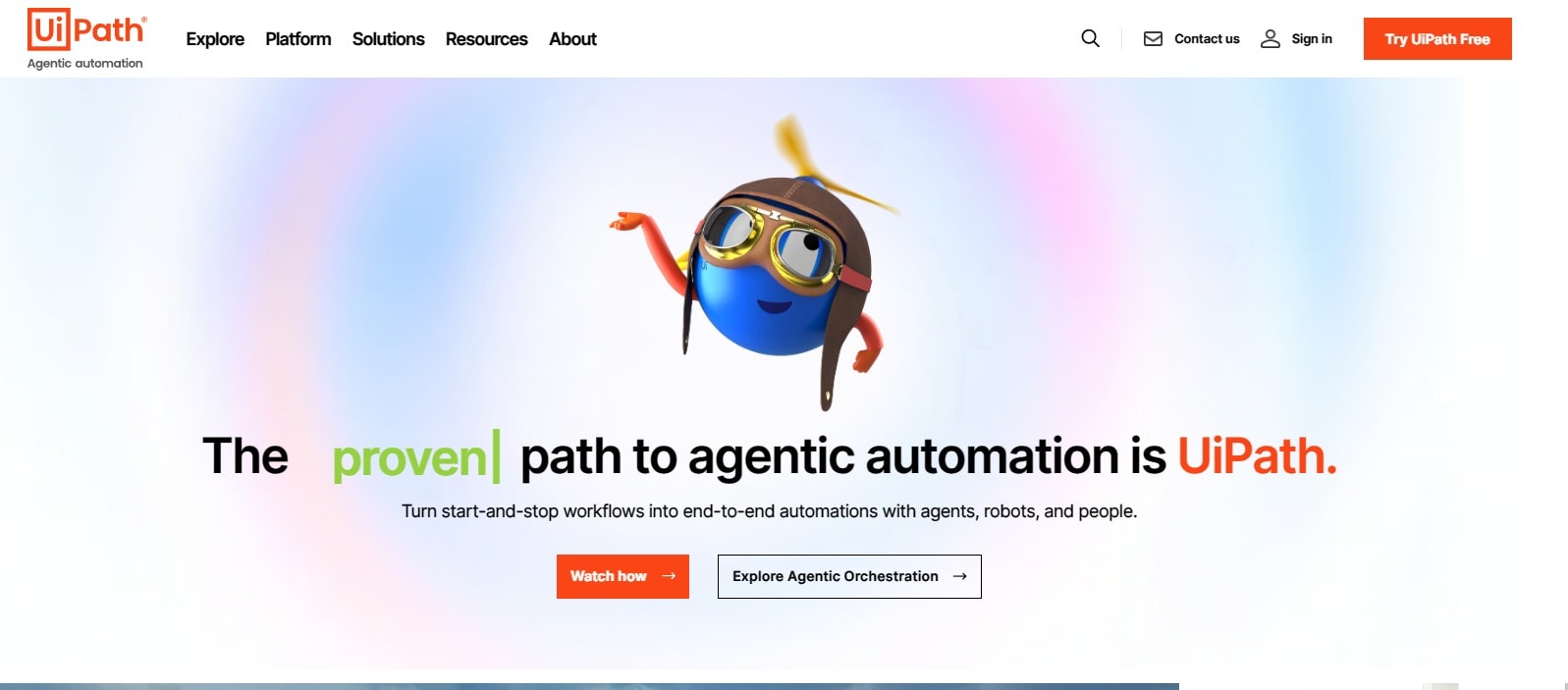
UiPath
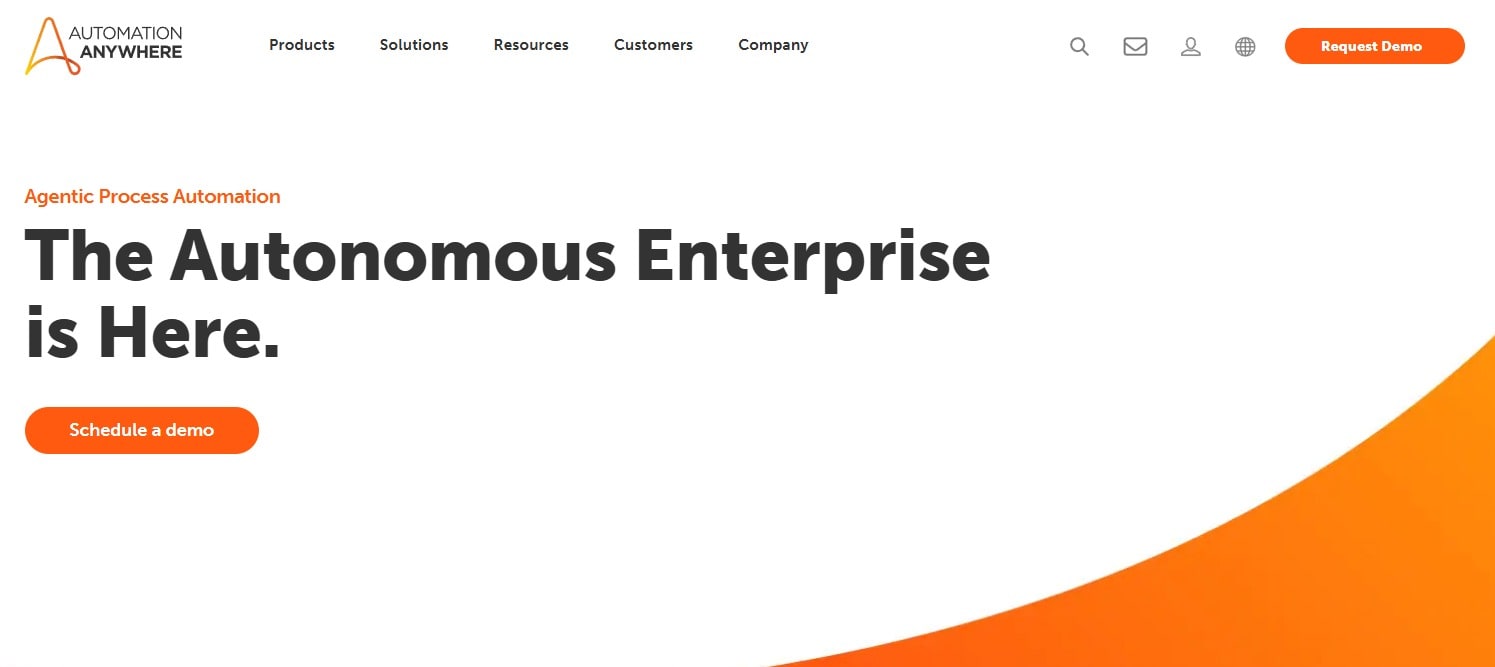
Automation Anywhere
Find an AI expert on Fiverr
Automation use cases
Customer service
AI automation can boost efficiency and improve the customer experience while reducing the burden on human resources.
AI-driven chatbots can provide answers to most customer questions.
Predictive analytics can anticipate customer needs and take action, such as sending a marketing email if the customer shows interest in a specific category of products.
Inventory management
AI automation in inventory management can optimize stock levels or predict demands. Predictive analytics might also predict seasonality and trends, which could trigger automated actions in a separate RPA tool.
Computer vision cameras can track stock in real time, triggering new orders when stock levels run low.
A data analytics AI solution could identify slow-moving items and then enable dynamic pricing or promotions to get the items moving faster.
Decision-making
Before AI solutions, automated decision-making tools were limited due to their rules-based nature. Creating advanced decision-making systems required complex workflows and decision trees.
AI automation is a massive breakthrough in decision-making processes, offering optimizations that simply wouldn’t be possible using a traditional system.
Machine learning on massive datasets opens the door to highly accurate predictive analytics and forecasting solutions.
Insurance
Machine learning solutions in insurance can assess risk profiles or use natural language processing (NLP) to preprocess claims before sending them to an agent.
Computer vision can analyze photos of damage and trigger actions based on the results.
One example of a company using AI computer vision in AI is Tractable. Its computer vision technology can assess vehicle damage. The company provides APIs that insurers can connect to if they want to build an AI automation solution into their apps.
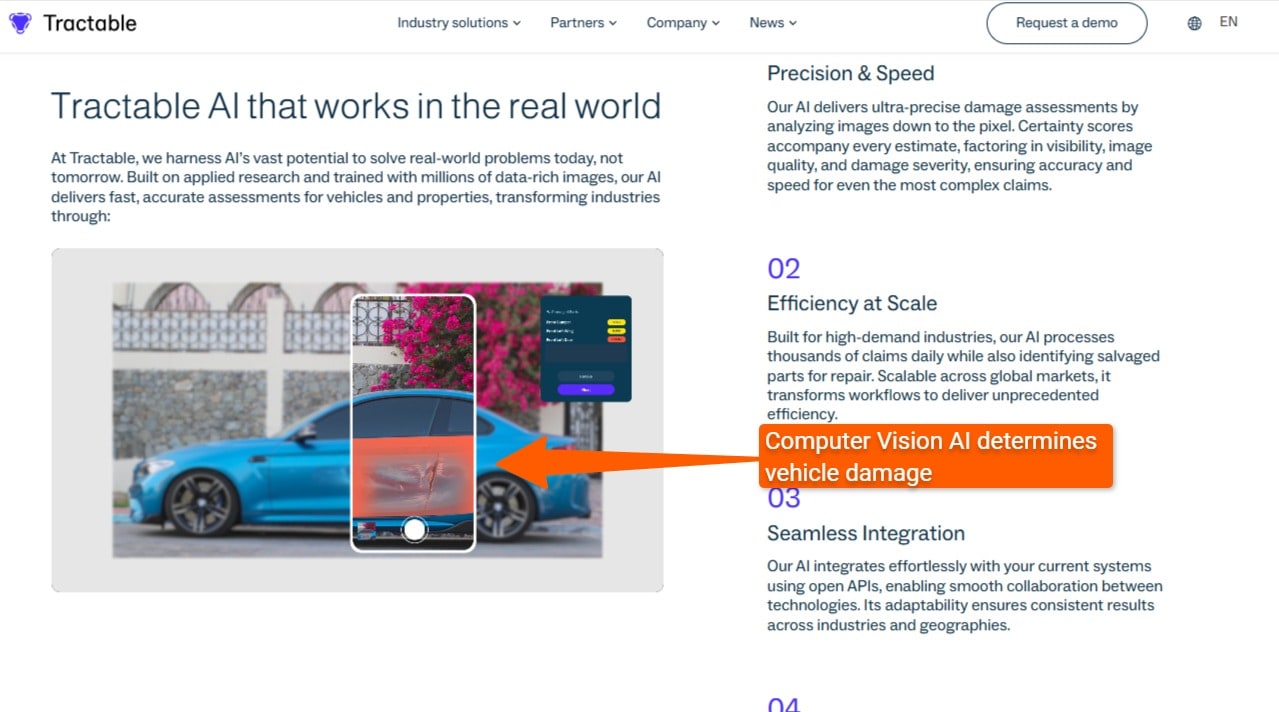
Tractable
Healthcare
The healthcare sector is undergoing a massive digital transformation, which gained momentum during the COVID-19 pandemic.
Many healthcare providers now offer AI chatbots that provide automated responses to help with the most common ailments and questions.
A company called Medisafe uses behavioral AI to help people manage their medications so they don’t underdose or overdose mistakenly.
Supply chain
One of the sectors that can benefit the most from AI automation is the supply chain sector.
AI automation applies at any phase of a supply chain to handle inventory, forecasting, product tracking, and predicting delays or demands. Data analytics can help supply chains balance costs with speed.
Human resources
AI chatbots and other NLP solutions can automate the employee onboarding experience. Sentiment analysis bots can detect employee moods and thus trigger appropriate actions. For example, a frustrated employee might benefit from training.
HR can also use predictive analytics to establish when the company might need to take on more temporary personnel.
Look for an expert AI prompt engineer on Fiverr
Benefits of AI automation
Frees up employees' time
Thomson Reuters’s latest Future of Professionals report surveyed 2,200 professionals in the legal, tax, and compliance sectors. The respondents said that AI has the potential to save them 12 hours per week within the next five years.
For example, an AI automation system could process incoming legal documents, summarize and categorize them, and then save them in a database for easy lookup.
Lowers costs
AI automation can reduce operational expenses by minimizing manual labor and reducing human errors.
An article by the BBC reveals how AI found a medical hypothesis in only 48 hours, which a medical team had spent years trying to discover.
The legal profession has also recognized that AI chatbots are incredibly capable of answering legal questions, which can reduce the cost of having someone manually do it.
Improves efficiency
AI automation can streamline processes by executing tasks faster and with real-time adaptability.
In manufacturing, machine learning helps with “predictive maintenance,” which predicts when machines might break down so they can be fixed before that.
Machine learning can help systems improve by processing historical data to understand past trends and inefficiencies.
Scales more effectively
AI can help companies evaluate massive datasets rapidly, quickly providing the insight necessary for scalable solutions.
AI automations allow businesses to process data at volumes and velocities well beyond those capable by humans.
Challenges of AI automation
Several challenges exist in AI automation, some more easily handled than others.
Inaccuracies
The first major challenge is inaccuracy, which is more prevalent in the field of generative AI than in any other field.
Generative AI tends to “hallucinate,” a technical term meaning that the AI is producing answers that don’t logically follow from its training data.
The problem is magnified in an automated solution because the automated response will occur without human intervention. If the AI hallucinates, the automated response might cause irreparable damage.
Several potential solutions exist, such as requiring a human to approve any automated actions created by the AI solution manually. Another possible solution is building in checks where one AI tool verifies the outputs of another AI tool.
Fiverr’s expert AI technology consulting can help you figure out the best way to overcome this challenge.
Data biases
One of the major issues with machine learning and its accompanying AI solutions is that their datasets are often biased.
When trained on biased historical data, AI automation can perpetuate those biases because its responses will be based on inaccurate data.
Wrong data leads to incorrect conclusions or, as commonly said in computer science, “Garbage in equals garbage out.” When you feed an AI solution low-quality data, you’ll get low-quality responses and automations in return.
The solution to this is to make sure your data is clean and that it comes from accurate sources.
Find an Expert Data Cleaning for Hire
Data privacy
Major concerns about generative AI and data privacy arose after ChatGPT’s release.
When AI is trained on data, there’s no way to remove that data from its learning, which contrasts with how traditional data stores work.
Building guardrails that prevent AI from being trained on sensitive data or releasing sensitive data is possible. One of Fiverr’s AI consultants can guide you through this.
Hire an AI automation specialist on Fiverr today
AI is an advanced topic, and getting help from an expert will allow you to use it to its maximum potential.
Fiverr is a platform with expert freelancers across all major business fields, such as marketing, software development, content creation, and AI.
Fiverr AI freelancers also work in machine learning, AI consulting, AI integrations, AI chatbot development, and AI fine-tuning. No matter what AI automation you want to implement, there’s an AI freelancer on Fiverr who is ready to help you.
Getting started on Fiverr is easy. Just open an account for free and search for the right freelancer today.
AI automation FAQs
What is AI automation?
AI automation is a form of automation that tries to mimic human intelligence. It leverages various AI technologies, such as computer vision, natural language processing, and speech recognition.
AI automation is more scalable than traditional rules-based solutions.
What types of technology are used in AI automation?
AI automation combines traditional automation technology, such as robotic process automation (RPA), with any AI/ML technology, such as computer vision or natural language processing.
Which AI is best for automation?
You can use any AI technology in AI automation so long as you connect it with a tool that can carry out that automation. For example, an AI-powered robot might use computer vision and deep learning to operate in its environment. However, the moving and acting are achieved through traditional mechanics, transistors, memory, and CPUs.
How do you learn AI automation?
AI automation is a huge topic made up of many subtopics. To get started, learn the fundamentals of AI and ML, then move to learning a hands-on programming language such as Python. You can also test basic automations on a platform like Zapier.





